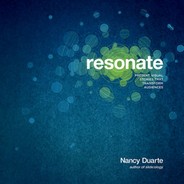
110 Resonate
Stories strengthen presentations by adding meaning.
Used well, stories, analogies, and metaphors help create
significance and stimulate the senses. Stories can be
one sentence long or weave through an entire presenta-
tion as a theme (page 156).
Stories are easy to repeat. Transforming information
into an anecdotal format charges the information emo-
tionally and puts it into a readily digestible format.
Turn Information Into Stories
BEGINNING
When
Once upon a time
In 1993
Two months ago
Years ago
In ten years
Transition
there was
I heard about
I bought
I saw
there will be
Who/What
a manager
a person (name)
a computer
a car
an event
Where
in marketing
in Singapore
on eBay
in a garage
somewhere
MIDDLE
Context
At the time
This was happening
Conflict
Which put us in conflict with
We knew that couldn’t continue
The results weren’t acceptable
Proposed Resolution
So
We tried this
Complication
(Optional but effective)
• What risks were there?
• Were you worried?
• What if it failed?
END
Actual Resolution
In the end … (doesn’t
have to be positive)
MIP (Most Important Point)
What’s the moral or core message?
Below is a template that uses a shortened version of
The Hero’s Journey.
9
You can add as many details and
descriptive flourishes with which you’re comfortable,
but the basic structure remains sound. Think about
what types of information help illustrate your point
best and turn some of that information into a story
format. To the right are examples of how the template
below transformed information into story.
Short Story Template
10
CH005.indd 110CH005.indd 110 8/16/10 4:26:02 PM8/16/10 4:26:02 PM

Create Meaningful Content 111
STORY ABOUT ORGANIZATIONAL CHANGE
11
STORY ABOUT CUSTOMER INTEREST
POINT YOU
WANT TO MAKE
Every cross-divisional function could
benefit from a steering committee.
Midsized companies would save money
if they bought this software.
BEGINNING
When, Who,
Where
A few years ago, the sales team tackled
a problem that demonstrates the cross-
divisional issues I’m talking about.
Last year I met with Susan, the CEO from
a company very similar to yours.
MIDDLE
Context At the time, all sales groups
were independent.
She was strategically wicked-smart, and,
just like you, she was curious whether our
software could help her business.
Conflict This means we were confusing the
customers with many different rules,
processes, and formats.
She knew that her organization wouldn’t
scale if she didn’t have software that
worked in a global environment.
Proposed
Resolution
So we decided to create a sales-
steering committee.
We installed a trial version for the
employees in the Dallas office only.
Complication You can imagine how hard it was to
reach agreement on anything.
She was concerned that the employees
would have a dip in productivity while
learning a new program.
END
Actual
Resolution
But we agreed to meet every two weeks
to discuss common ground. Over the
next year, we standardized all our pro-
cesses and learned a lot from each other.
The customers were much happier with
our service.
Instead, employee productivity increased,
and Susan received numerous e-mails
about how the software will help them
gain market advantage.
It took her less than a week to agree to an
organization-wide installation.
MOST
IMPORTANT
POINT
I think every cross-divisional function
could benefit from a steering committee.
Your company has the same challenges
and would benefit, too.
CH005.indd 111CH005.indd 111 8/16/10 4:26:02 PM8/16/10 4:26:02 PM
..................Content has been hidden....................
You can't read the all page of ebook, please click here login for view all page.
